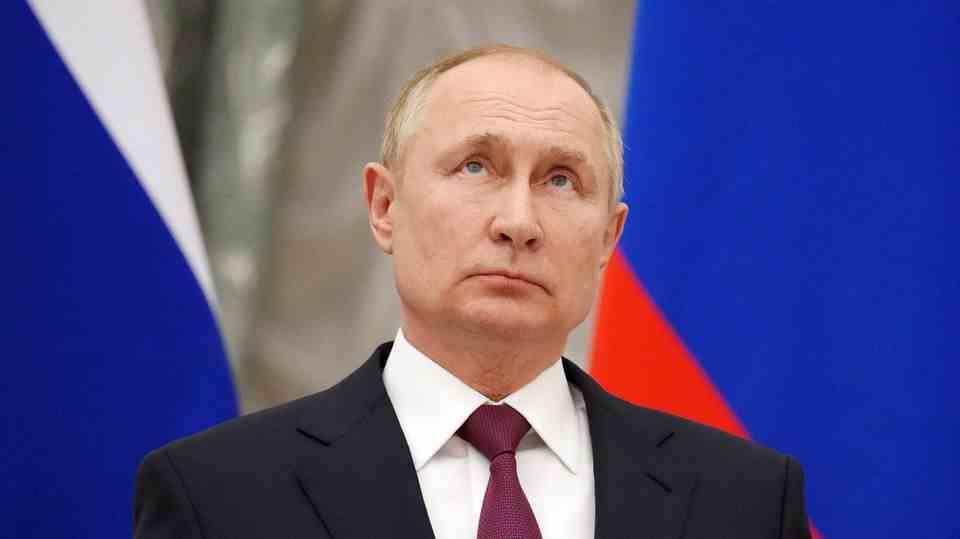The sanctions for the attack on Ukraine endanger Russia’s debt service. Last week Moscow settled its foreign liabilities for the first time in rubles only. Can the Kremlin still prevent a default?
Russia’s economy is groaning under the sanctions imposed by the West over Russia’s invasion of Ukraine. The vast empire is subject to drastic trade restrictions and is cut off from much of the financial world.
Last week, the US Treasury Department announced that Russia would no longer be allowed to settle its dollar-denominated debt through American banks. As a result, Moscow paid its foreign debt for the first time only in rubles, instead of in the US currency, as originally planned. Overall, it was payments for bonds worth 649.2 million dollars (595.3 million euros). As a result, the US rating agency Standard & Poor’s (S&P) lowered the country’s creditworthiness to “Selective Default”, indicating a partial default.
Although the Kremlin has built up gold and money reserves worth more than 600 billion dollars for years to secure its own economy, nobody wants to buy the gold in the course of the trade boycott and about half of the money is parked in foreign accounts, frozen there by the West – and unattainable for Moscow.
This puts Russia on the brink of defaulting on its foreign debt for the first time since the Bolshevik revolution more than a century ago.
Is a default for Russia inevitable?
It’s starting to look that way, as the US and its allies have made it extremely difficult for Russia to make the planned payments in dollars as part of their efforts to isolate the country from the global financial system. This includes the US Treasury Department’s new crackdown on Russian dollar orders. Washington wants to force Moscow to either use up its foreign exchange reserves remaining domestically or to use new income, for example from oil and natural gas sales, to pay down bonds. wrote the Swiss “Handelzeitung”. and the “New York Times” called the measure “a move aimed at depleting the country’s international reserves and potentially pushing Russia into its first foreign-currency default in a century.”
This is exactly what the US government has in mind: Moscow has the choice between slowly exhausting its valuable foreign exchange reserves and declaring national bankruptcy, announced US President Joe Biden’s spokeswoman, Jen Psaki, last Wednesday in Washington.
Experts and rating agencies have been warning of an impending bankruptcy in Russia for weeks. However, due to the exceptional situation caused by the sanctions, it should initially only be a question of a technical or partial payment default, not a state insolvency in the strict sense.
These Russian airlines are now on the EU black list
21 images
Kremlin spokesman Dmitry Peskov, on the other hand, assured that there was no reason for a national bankruptcy. “Russia has all the resources it needs to pay off its foreign debt,” he said a week ago. At the same time, Peskov complained that “substantial amounts of our reserves” were frozen and blocked abroad. If this situation persists, Russia will be forced to switch to ruble payments. An “artificial bankruptcy situation” could only be brought about if the ruble payments were also blocked.
What would be the impact of a payment default?
It would further isolate Russia in the global economy. Moscow has already announced that in view of the economic sanctions it will no longer place government bonds on the international markets – probably also because there is hardly any market for them. In his estimation, the income from the sale of oil and gas, among other things, is sufficient to cover the state’s current expenses, Economy Minister Anton Siluanov said on Monday.
By not selling government bonds, President Vladimir Putin’s government loses an important means of obtaining foreign currency. And should the oil and gas embargo against Russia currently being discussed in the European Union become a reality, the Kremlin’s ability to obtain money in foreign currencies would be even more restricted.
A default would also have historical symbolism that could cast a shadow of weakness over Putin. It would be the first time since the Russian Revolution in 1917 that Russia would have to let its foreign creditors down. Although there was also a payment default in 1998 as a result of falling oil prices and the Asian crisis, this only affected internal debt in rubles.

On the other hand, the risk of a Russian bankruptcy has already been factored into the financial markets. However, it is considered to be manageable due to the relatively small number of international links. Most analysts do not expect a financial market shock. The head of the International Monetary Fund IMF, Kristalina Georgieva, described the commitment of international banks in Russia in March as “definitely not systemically important”.
According to the most recent data from the Deutsche Bundesbank from November 2021, the claims of German banks on Russia amounted to around six billion euros. Including the claims of their foreign branches and subsidiaries, it was around 7.5 billion euros. According to the Bundesbank, this is just under 0.4 percent of the total foreign claims of German institutions. The securities of public households in Russia at German banks amounted to 119 million euros.
So are foreign investors losing their money now?
Not necessarily, but most investors will have to go through a lengthy legal battle to collect their debt.
Although Russia has not been a big seller of foreign bonds, major hedge funds and asset managers including Invesco and Pimco have bought bonds, as reported by the US broadcaster National Public Radio (NPR).. Russia has 15 outstanding bonds denominated in dollars and euros, with a total value of around $40 billion, according to US securities dealer Morgan Stanley. A large part of the Russian bonds were therefore registered in Great Britain, which is also likely to be where most of the court proceedings will take place.
In any case, Russia’s creditors must be prepared for long and complicated processes in the event of court proceedings. After Argentina’s 2001 default, several attempts were made to restructure the country’s debt, NPR reports. Overall, the negotiations lasted more than a decade.
Sources: “capital”, “Business Insiders”, extra, “Trade Newspaper”, “New York Times”, National Public RadioDPA



